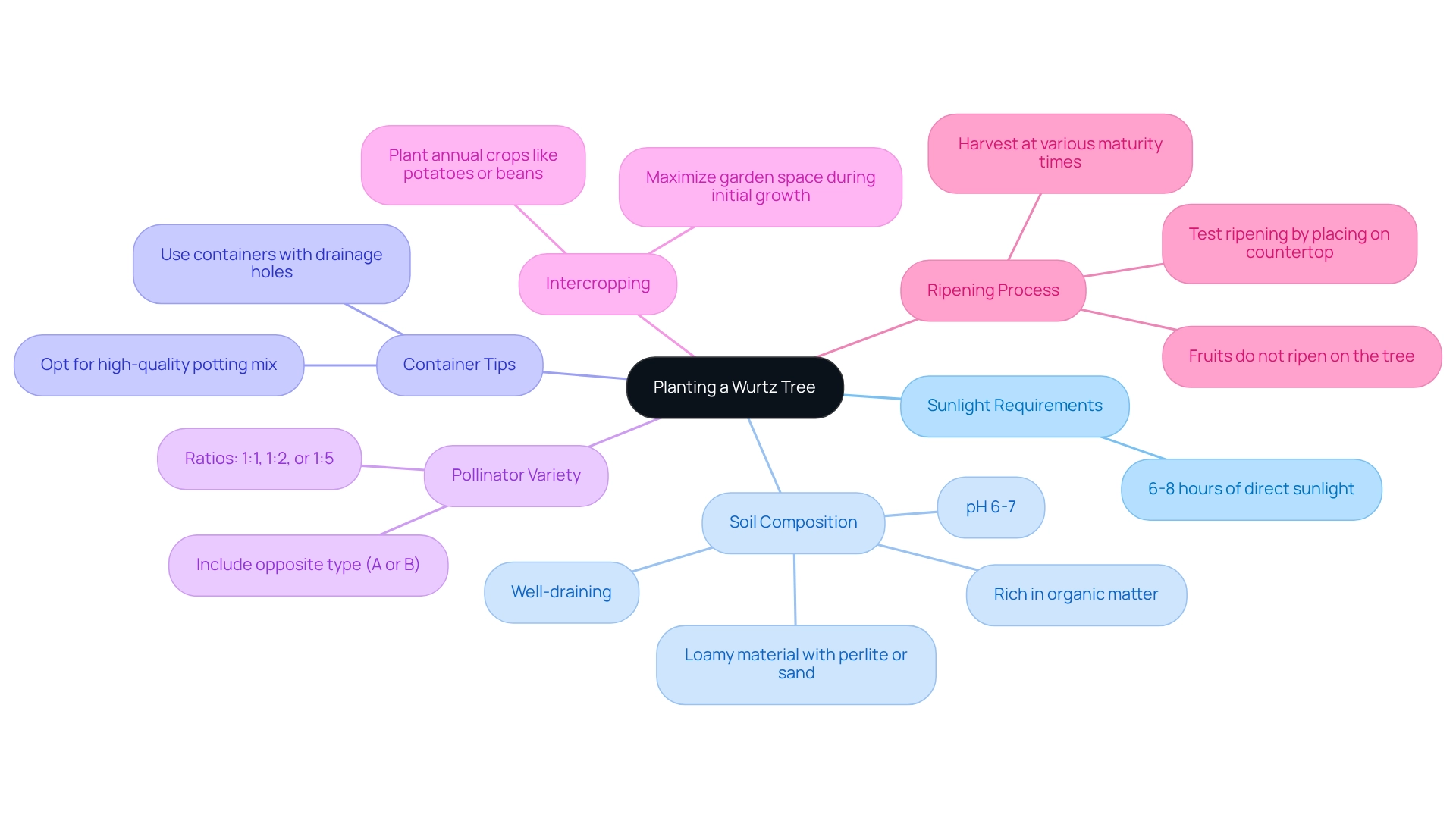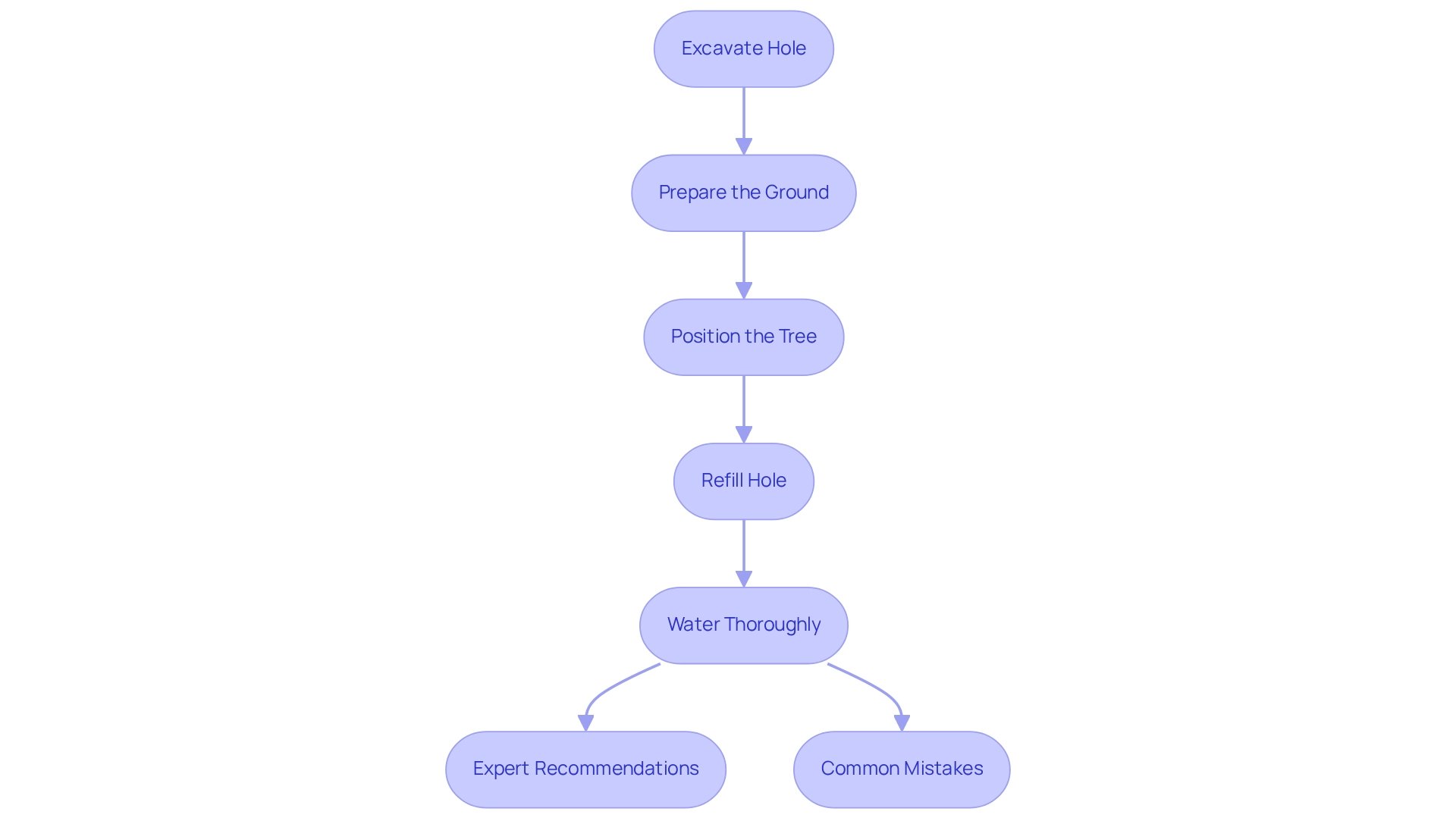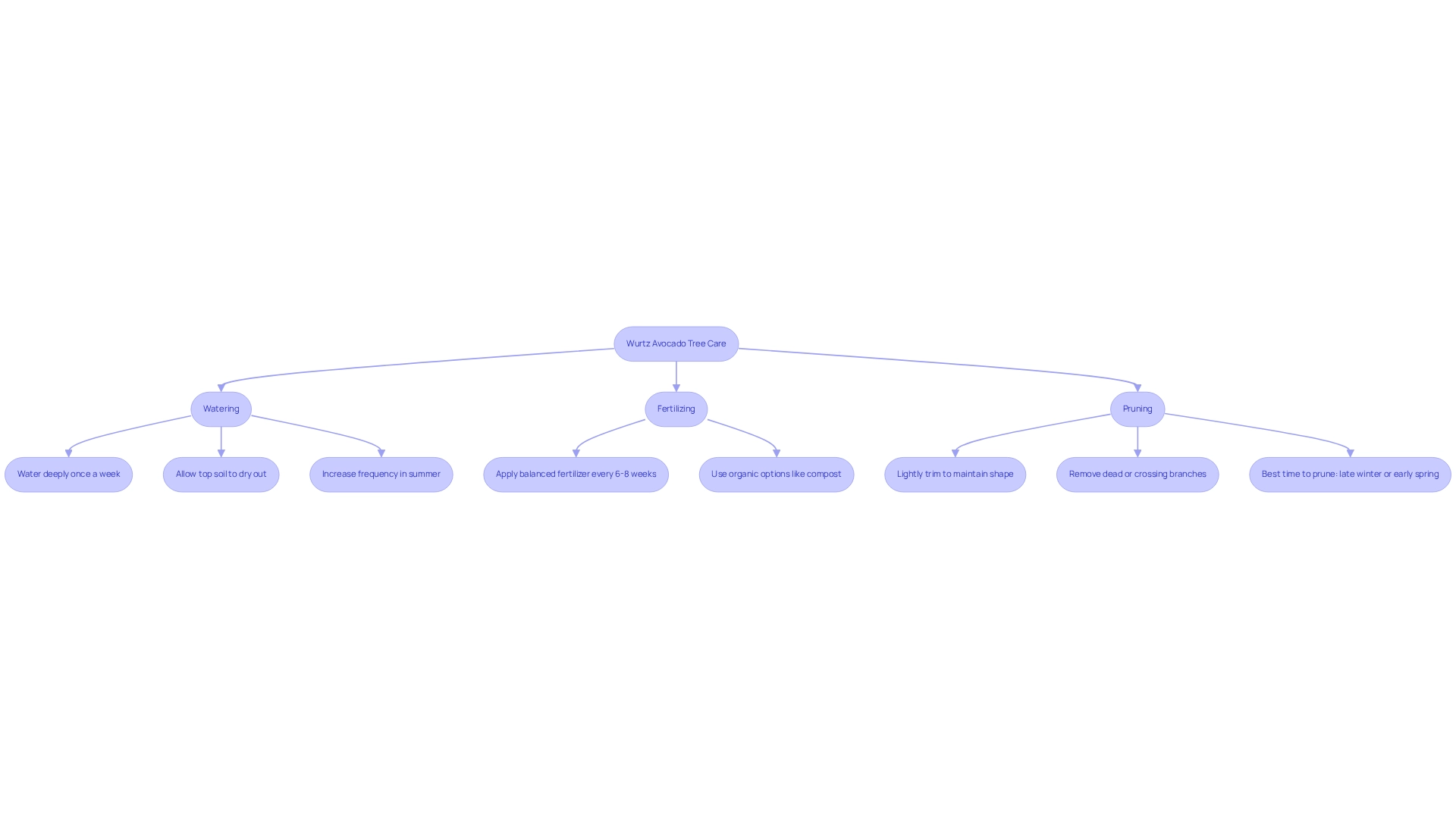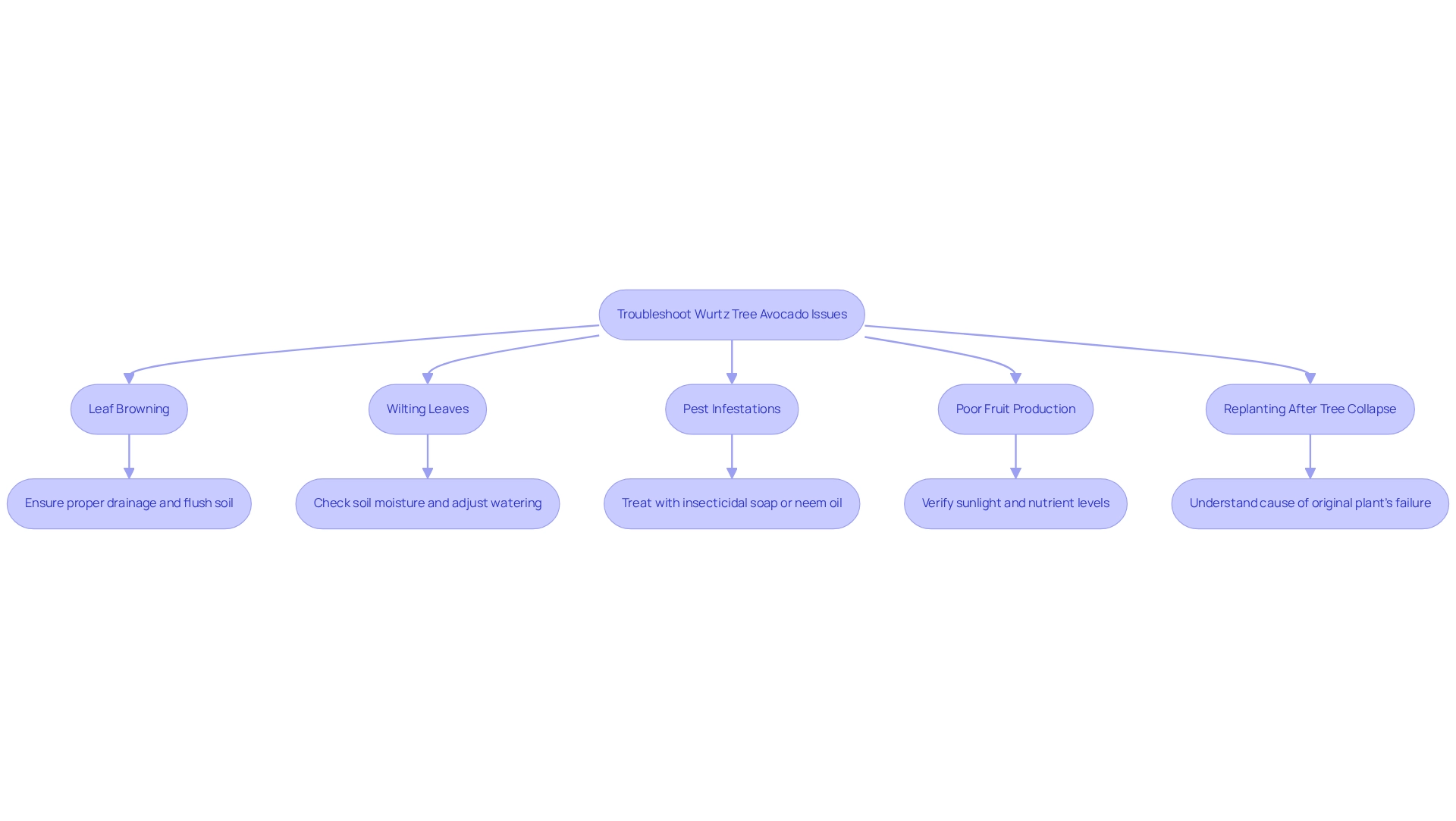
Wurtz Tree: Essential Steps for Successful Planting and Care
Share
Successfully planting and caring for your Wurtz avocado tree can be a rewarding experience, but it starts with a few essential steps. First, consider selecting the right location where your tree can thrive. Next, take the time to prepare the soil adequately, as this is crucial for your tree's health. Remember to maintain proper watering and fertilization practices to nurture your tree as it grows.
It’s important to recognize that common issues, such as overwatering or pest infestations, can arise. Understanding these challenges helps us take proactive measures to ensure our trees not only survive but flourish. By addressing these concerns with care, we can enhance our gardening experience and enjoy the fruits of our labor.
As you embark on this journey, know that you are not alone. Many gardeners face similar challenges, and together, we can overcome them. Embrace the process, and don't hesitate to seek out advice or share your experiences with fellow gardeners. With patience and dedication, your Wurtz avocado tree will reward you with bountiful fruit, enriching both your garden and your heart.
🥑 Ready to grow creamy avocados in your own backyard?
The Wurtz Avocado Tree, also known as "Little Cado," is a compact and prolific fruit tree ideal for small gardens and container growing. This guide will walk you through how to plant, care for, and troubleshoot your Wurtz tree for a bountiful harvest.
👉 Shop the Wurtz Avocado Tree — shipped from Everglades Farm with expert care.
🌿 Explore the Avocado Trees Collection — find the right tree for your space.
In the world of home gardening, few delights can compare to the satisfaction of growing your own avocados. The Wurtz avocado tree, affectionately known as "Little Cado," truly stands out as an ideal choice for enthusiasts like you. This compact, semi-dwarf variety not only yields creamy, flavorful fruit within a remarkably short timeframe but also thrives in limited spaces, making it perfect for container gardening.
Imagine the joy of plucking fresh avocados right from your own tree! With its self-pollinating nature and the potential for enhanced fruit production when paired with another variety, the Wurtz avocado tree offers a unique blend of convenience and taste that can transform your gardening experience.
As you embark on the journey of planting and nurturing this delightful tree, understanding its specific needs—from soil conditions to watering practices—becomes essential for a fruitful harvest. Whether you are a seasoned gardener or just starting out, the promise of fresh, homegrown avocados is an enticing prospect that invites exploration into the care and cultivation of this remarkable tree. Let's dive into this rewarding adventure together!
1. Understand the Wurtz Avocado Tree
Meet the delightful fruit-bearing plant, affectionately known as 'Little Cado.' This compact, semi-dwarf variety typically reaches heights of 8 to 10 feet, making it a charming addition to any garden. What makes it truly special is its rich, tasty produce, which can ripen within just 1 to 2 years after planting. Imagine the joy of enjoying fresh fruit from your own garden! This makes 'Little Cado' an appealing choice for home gardeners eager to savor the fruits of their labor.
Thriving in warm environments, this variety is particularly well-suited for container gardening. This means that even if you have limited outdoor space, you can still grow your own fruit and experience the wonders of gardening. Isn't that wonderful? Self-pollinating by nature, the Wurtz tree variety can also benefit from being planted alongside another type, which significantly enhances fruit production. Understanding its growth habits is essential for effective garden planning. For example, while the tree can be brought indoors during freezing conditions, it does require high humidity levels to flourish, ensuring it remains healthy and productive.
The story of this variety adds to its unique charm. Propagated in 1935 by Roy from a chance seedling in Encinitas, California, it has since become a favorite among fruit enthusiasts. This hybrid variety not only boasts a rich flavor profile but also integrates seamlessly into small gardening areas. As Mr. Wurtz beautifully put it, 'This combination of compact size, continual fruiting, and delicious produce makes the Wurtz tree a favored option among home gardeners and fruit enthusiasts who seek both convenience and outstanding flavor.' With proper care and attention, you too can cultivate this delightful plant, reaping the rewards in a relatively short time frame.
A customer from California shared their success story, reporting positive growth in their Lil Cado fruit plant after diligently following planting directions for just two weeks. This illustrates the potential for success with this wonderful variety. So, why not take the plunge and nurture your own 'Little Cado'? You may just find that gardening brings you joy and fulfillment beyond measure.
2. Prepare for Planting: Soil and Location Requirements
To successfully plant a wurtz tree, it’s essential to choose a location that receives at least 6 to 8 hours of direct sunlight each day. The soil should be well-draining, rich in organic matter, and slightly acidic to neutral (pH 6-7). A blend of loamy material with perlite or sand can significantly improve drainage. If you’re planting in a container, be sure it has drainage holes and opt for a high-quality potting mix.
It’s wise to steer clear of heavy clay soils, as they tend to retain too much moisture, which can lead to root rot; when selecting your planting spot, especially for a wurtz tree, consider the mature size of the plant to ensure it has ample space to flourish.
Remember, including a 'pollinator' variety (of the opposite type, A or B) in a ratio of 1:1, 1:2, or 1:5 is crucial for successful fruiting. Have you thought about incorporating annual crops like potatoes or beans between your tree rows? This can yield profits during the initial years of growth, maximizing the use of your garden space.
Understanding the ripening process of these fruits is equally important. They do not mature while still attached to the plant, so knowing when to pick them can help you enjoy them at their peak freshness. Gardening is a journey, and with these steps, you’re well on your way to nurturing a fruitful avocado tree!

3. Plant the Wurtz Avocado Tree: Step-by-Step Instructions
- Start by excavating a hole that is twice the width and equal in depth to the root ball of your wurtz tree avocado plant. This spacious hole allows the roots to spread freely, promoting healthy growth and giving your plant the best chance to thrive.
- Prepare the Ground: Enrich the excavated earth by mixing it with compost or well-rotted manure. This nutrient-rich mixture will provide essential support for your young plant, enhancing its chances of flourishing in its new home.
- Position the wurtz tree: Carefully place the wurtz tree avocado in the center of the hole, ensuring that the top of the root ball is level with the surrounding earth. Be mindful not to plant too deeply, as this can suffocate the roots and hinder growth.
Gently refill the hole with the prepared material, pressing down lightly to eliminate any air pockets. As you fill, water the ground to help settle it and ensure good contact with the roots, nurturing them right from the start.
- Water Thoroughly: After planting, give your plant a deep watering to help establish its roots. For the initial weeks, keep the soil damp without excessive watering—this balance is vital for your plant's successful establishment.
- Expert Recommendations: To optimize growth, consider applying mulch around the base of your plant, but remember to keep it away from the trunk to prevent rot, as noted by Dr. Ben Faber. Additionally, recent studies suggest that high-density planting methods can enhance productivity, with ideal planting density varying from 200 to 4000 plants per hectare. Observing your plant's growth for success.
Common Mistakes: It's important to avoid overwatering, which can lead to root rot, and ensure that your tree is not planted too deep. Correct placement and ground preparation are essential for successful planting. Insights from case studies on canopy management in fruit orchards underscore the importance of effective pruning and growth regulation for maintaining productivity, highlighting the need for ongoing research to optimize these practices. Remember, gardening is a journey, and with each step, you're nurturing not just a plant but a beautiful connection to nature.

4. Maintain Your Wurtz Avocado Tree: Watering, Fertilizing, and Pruning Tips
To effectively care for your Wurtz avocado tree, let’s explore some essential practices together that will nurture both you and your plant:
-
Watering: It's important to water your tree deeply once a week, allowing the top few inches of soil to dry out between waterings. As the heat of summer approaches, you might find yourself needing to water more frequently to keep your tree happy and stress-free. Remember, avocados are particularly sensitive to overly wet conditions, which can lead to root decay and nutrient loss. As one farmer wisely shared, "Flooding is not desirable as it promotes root rot as well as water and nutrient runoff and should always be avoided, in my opinion."
-
Fertilizing: Consider applying a balanced fertilizer designed specifically for fruit plants every 6-8 weeks during the growing season. Organic options, like compost or fish emulsion, can also enrich the soil and encourage vibrant growth. Tailoring your fertilization plan to meet your tree’s unique needs will help ensure the best results.
-
Pruning: Lightly trimming your plant can help maintain its shape while removing any dead or crossing branches. This simple act promotes better air circulation and sunlight penetration, both vital for fruitful development. The best time to prune is late winter or early spring, just before new growth begins.
As you care for your tree, keep in mind that seasonal crop coefficients tend to be higher in summer and autumn. This may mean adjusting your watering frequency during these times. By following these nurturing guidelines and insights, you can help your Wurtz tree thrive, ensuring it produces delicious fruit for many years to come. Together, let’s cultivate a garden that flourishes with life and joy.

5. Troubleshoot Common Issues: Signs of Stress and Solutions
Common issues with the wurtz tree avocado can be concerning, but understanding them is the first step toward nurturing your plants back to health. Here are some common challenges you might encounter:
-
Leaf Browning: This symptom often indicates overwatering or salt buildup in the soil. To address this, ensure proper drainage and consider flushing the ground with water to eliminate excess salts. Remember, a little care can go a long way in reviving your tree's vibrancy.
-
Wilting Leaves: If you notice wilting, it may suggest underwatering or root damage. Regularly check the soil moisture and adjust your watering schedule to maintain optimal hydration. Your attentive care can help your tree thrive again.
-
Pest Infestations: Keep an eye out for pests such as aphids or spider mites. Treat infestations promptly with insecticidal soap or neem oil, and conduct regular inspections of the leaves and stems to catch any issues early. Staying vigilant will ensure your plants remain healthy and strong.
-
Poor Fruit Production: If your plant is not yielding fruit, verify that it receives sufficient sunlight and nutrients. Identifying low-nitrogen areas can help optimize fertilization and increase productivity. Planting a compatible variety of fruit nearby can enhance pollination and improve fruit set. With the right care, your tree can flourish and bear fruit.
-
Replanting After Tree Collapse: If you need to replant a new fruit-bearing plant in the same hole after removing a fallen plant, it is essential to understand the cause of the original plant's failure. Successful replanting can occur without special soil treatment, provided the underlying issues are addressed to prevent recurrence. This thoughtful approach can lead to a fresh start for your garden.
Comprehending these frequent problems and their remedies is essential for preserving the wellbeing and productivity of the wurtz tree. By tackling these challenges proactively, we can ensure our plants flourish and yield plentiful fruit. As Greg Alder notes, "The symptoms you are observing on your young avocado tree – bumps, brownish green coloring, and brittle leaves – could be indicative of several issues." Let's work together to nurture our gardens and enjoy the fruits of our labor.

Conclusion
The Wurtz avocado tree, affectionately known as "Little Cado," offers a wonderful opportunity for home gardeners eager to cultivate their own avocados, even in cozy spaces. Its compact size, quick fruit production, and self-pollinating nature make it a perfect choice for both novice and seasoned gardeners. To set your tree up for success, it's essential to select the right location, understand soil needs, and follow proper planting techniques, ensuring a healthy tree that flourishes and bears delicious fruit.
To keep your Wurtz avocado tree thriving, consistent care is vital. This includes proper watering, fertilizing, and pruning. Being aware of common issues like leaf browning or pest infestations empowers you to troubleshoot effectively, helping your tree remain productive. By addressing these challenges with proactive solutions, you can turn the dream of enjoying fresh, homegrown avocados into a delightful reality.
Ultimately, nurturing a Wurtz avocado tree enriches your gardening experience and brings the rewarding joy of savoring creamy, flavorful avocados straight from your backyard. With the right knowledge and a little dedication, you can embark on this fruitful journey, transforming your gardening space into a haven of fresh produce. Are you ready to take the first step towards enjoying your own avocados?
🥑 Ready to Plant Your Wurtz Avocado Tree?
Start your gardening journey today with the Wurtz (Little Cado) Avocado Tree.
Looking for more?
Frequently Asked Questions
What is 'Little Cado' and what are its main characteristics?
'Little Cado' is a compact, semi-dwarf avocado tree variety that typically grows to heights of 8 to 10 feet. It is known for its rich, tasty fruit, which can ripen within 1 to 2 years after planting.
Where is 'Little Cado' best suited for growing?
'Little Cado' thrives in warm environments and is particularly well-suited for container gardening, making it ideal for those with limited outdoor space.
Does 'Little Cado' require another tree for pollination?
While 'Little Cado' is self-pollinating, planting it alongside another variety can significantly enhance fruit production.
What are the care requirements for growing 'Little Cado'?
'Little Cado' requires high humidity levels to flourish and can be brought indoors during freezing conditions. It also needs at least 6 to 8 hours of direct sunlight each day and well-draining, slightly acidic to neutral soil.
How should the soil be prepared for planting a Wurtz tree?
The soil should be rich in organic matter and well-draining, ideally a blend of loamy material with perlite or sand. Avoid heavy clay soils, as they retain too much moisture and can lead to root rot.
What is the importance of including a pollinator variety when planting a Wurtz tree?
Including a pollinator variety (of the opposite type, A or B) in a ratio of 1:1, 1:2, or 1:5 is crucial for successful fruiting.
Can annual crops be planted alongside 'Little Cado'?
Yes, incorporating annual crops like potatoes or beans between tree rows can yield profits during the initial years of growth, maximizing garden space usage.
How do you know when to pick the fruits from 'Little Cado'?
The fruits do not mature while still attached to the plant, so understanding the ripening process is important to enjoy them at their peak freshness.


